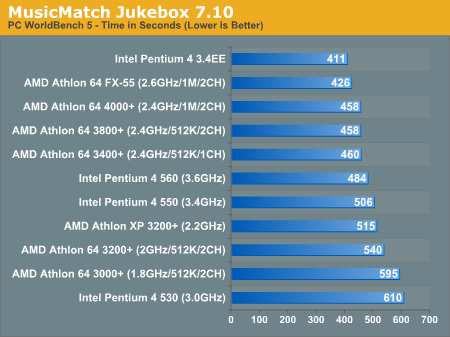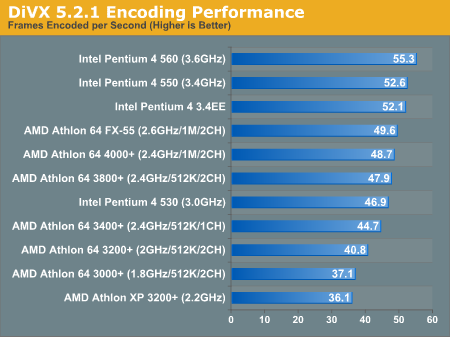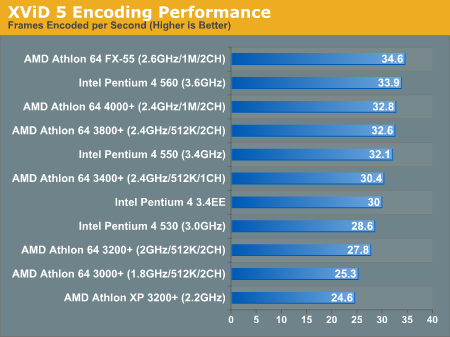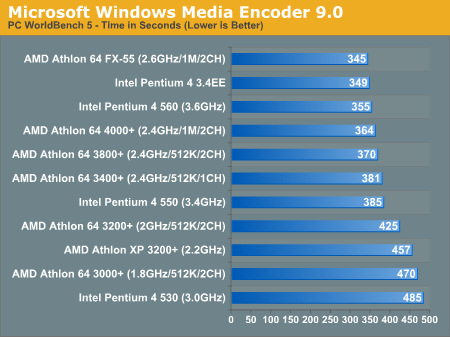AMD Athlon 64 4000+ & FX-55: A Thorough Investigation
by Anand Lal Shimpi on October 19, 2004 1:04 AM EST- Posted in
- CPUs
Audio/Video Encoding
MusicMatch Jukebox 7.10
An audio encoding favorite of Intel's from past Pentium 4 launches, MusicMatch Jukebox shows the Pentium 4 3.4EE taking a small 3.5% lead over the FX-55. Despite Intel's first place victory here, AMD takes the next four spots. Once again we see that there's no performance difference between the 3800+ and the 4000+, but looking at the lack of performance improvement from the 3400+ to 3800+ jump we see why: MP3 encoding is quite CPU bound, larger caches and more memory bandwidth don't matter much, it's all about clock speed here. Thus it's not too surprising to see the Athlon XP 3200+ outperform the Athlon 64 3200+ thanks to a shorter pipeline and higher clock speed. AMD's on-die memory controller does little for it here, neither does Intel's Prescott core though.

DiVX 5.2.1 with AutoGK
Armed with the latest version of DiVX (5.2.1) and the AutoGK front end for Gordian Knot, we took all of the processors to task at encoding a chapter out of Pirates of the Caribbean. We set AutoGK to give us 75% quality of the original DVD rip and did not encode audio.
Despite AMD becoming more competitive in DiVX encoding performance, Intel once again pulls head, with the Pentium 4 560 pulling away as the fastest DiVX encoder out of the bunch. Even the more reasonably priced Pentium 4 550 is able to outperfom the Athlon 64 FX-55, and it's not until we drop down to the 3GHz mark that AMD is able to win any ground.
Heavy optimizations for NetBurst give Intel the DiVX encoding performance crown.

XViD with AutoGK
Another very popular codec is the XViD codec, and thus we measured encoding performance using it instead of DiVX for this next test. The rest of the variables remained the same as the DiVX test.
Using XViD the performance situation is flipped on us, this time instead of Intel being on top we're left with the Athlon 64 FX-55 - although it's worth mentioning that the Pentium 4 560 is close behind. To no surprise there's a noticeable increase in performance from the single channel 3400+ to the dual channel Socket-939 3800+ of 7% to be exact. Once again we see no performance boost for the additional cache of the Athlon 64 4000+.

Windows Media Encoder 9
To finish up our look at Video Encoding performance we've got two tests both involving Windows Media Encoder 9. The first test is WorldBench 5's WMV9 encoding test.
Here we see that the Athlon 64 FX-55 and Pentium 4 3.4EE are basically tied for the first place position, followed by the Pentium 4 560 and all of the 2.4GHz Athlon 64s. Here the Athlon 64 3400+ appears to do about as well as the Pentium 4 550, which is either saying a lot for the Pentium 4 550 or very little for the 3400+.

But once we crank up the requirements a bit and start doing some HD quality
encoding under WMV9 the situation changes dramatically.
Here the Pentium 4 560 takes the lead, followed by the Pentium 4 3.4EE
and then the FX-55. The performance difference between the Pentium 4 560
and
the FX-55 is just under 9%, enough to give Intel the clear win here. Only
the Pentium
4 530 is really able to be challenged by the AMD chips.

Closing up our video encoding tests, while AMD does win some, with appropriate optimizations in place Intel seems to be the right candidate here.










89 Comments
View All Comments
coolme - Monday, January 10, 2005 - link
#85 yeah, but when comparing to Tom's Hardware review, it's totally off track... (Tom's is more believeble because there is pics of how he measured it and based on the fact that there is no way a A64 could handle 200+ watts)http://www6.tomshardware.com/cpu/20041115/pentium4...
how Tom tested it: http://www6.tomshardware.com/cpu/20041115/pentium4...
eight - Monday, December 27, 2004 - link
Has anyone information about A64 performance with Premiere Pro 1.5? I assume thet A64 does beat P4, but assumption is mother of... :)euanw - Tuesday, November 9, 2004 - link
#44Wesley,
I am very impressed by your articles. Can you inform me of the procedure you used to overclock the FX55? With the Neo2 board I am not clear on CPU vid and CPU voltage, what do they mean? When I change the multiplier to 13.5 my new PC reaches winXP and then reboots.
My setup is MSI K8N-Neo2-54G, FX-55, 2 x 512MB - OCZ EL DDR PC-3200 Platinum Rev2, Nvidia Quadro FX3000, 2x Seagate Barracuda 7200.7 120 GB, Matrox RTX-100 real time video editor, Antec TrueBlue 480W ATX-12V, BenQ DVD Dual DW1610, WinXP-SP2.
euanw - Tuesday, November 9, 2004 - link
#44Wesley,
Gioron - Sunday, October 24, 2004 - link
While I'm unsure of the exact method used in this review, I'm sure that there is no built-in power measurement devices on the motherboards and processors listed (unless its new and no one told me...) so its NOT just just a matter of installing software that can read a sensor thats already there (as in all the CPU temp monitors). This means it requires some hardware to measure the voltage and current flow to various components (or you can cheat a little and assume the voltage is constant and just measure current).Unfortunately, this is not as easy as it sounds, since isolating various components can be a problem. Its fairly easy to measure things like hard drive power useage since there is only one power connector going to it and its easy to access, so you measure the current on the 5v line and the current on the 12v line, and you're pretty much done. Things like CPUs, motherboards and graphics cards are a bit more difficult. On the newer graphics cards you can measure the power consumption from the additional molex connector, but in all likelyhood, the card will also draw a certain amount of power from the AGP slot power lines, and no one in their right mind is going to unsolder the AGP slot and raise it half an inch in an attempt to put a current sensor in line with the power leads. Thus, you need to rely on indirect means and educated guesses. You can measure the current going into the motherboard, but how much of that is going to the chipset, the CPU, the RAM and the graphics card? You can swap in a different CPU and see how it changes, but that won't give you absolute readings. You can try to remove the CPU and see what power the MB uses without one, but odds are it'll use more power when its actually interfacing with a CPU instead of beeping error codes at you.
Bottom line: There is no easy way to measure power consumption, and even dedicated hardware review sites have problems with it. Personally, I trust Anand far enough that I'm sure he didn't completely screw it up, and the numbers he has are probably close enough to the real thing. I'd forget about measuring power for myself.
xsilver - Friday, October 22, 2004 - link
Kinda late on the comments but..If anand or anybody can answer -- what is used to measure the "power consumption" software? or hardware? links? I would like to test this myselfthanks
Bakwetu - Friday, October 22, 2004 - link
Whoah, it's been a while since I checked out cpu reviews and I must say Amd has some impressive cpu:s nowadays. Even though I am budget oriented when it comes to buying hardare, I'd choose the 3400+ model before the 3200+, it's not all that much more expensive and seems to perform much bettert - Friday, October 22, 2004 - link
79uhuh.... and in a server type situation, how many raid arrays are ran off the chipset controllers? not many i would wager..
hell... u prolly have an independent fibre optic raid array :)
hardware, baby, hardware.
t.
knitecrow - Friday, October 22, 2004 - link
I always knew women were trouble when it comes to technology ;)screech - Thursday, October 21, 2004 - link
nice ones #79, 78. :)